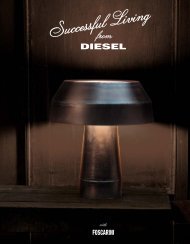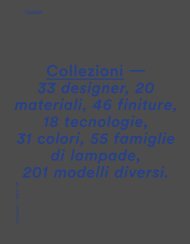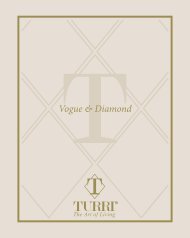Bluthner EN-no border
You also want an ePaper? Increase the reach of your titles
YUMPU automatically turns print PDFs into web optimized ePapers that Google loves.
1
2
LEIPZIG<br />
A legend is born ...<br />
Follow a successful company history that, at the same<br />
time, is also a family history.<br />
In the middle of the 19th century, the city of Leipzig<br />
was one of the cultural centres at the heart of Europe<br />
equal to Paris, London or Vienna. The enlight ened<br />
and affluent middle-class of Leipzig was very ambitious,<br />
self-confident and open minded, and the city<br />
itself was already well k<strong>no</strong>wn for its international<br />
trade and its university. Changing circumstances<br />
meant that scientific and cultural education was <strong>no</strong><br />
longer reserved for the aristocracy. During this<br />
period, the people of Leipzig prospered.<br />
The advancements during this time can be seen in the<br />
history of the University of Leipzig, and in the prominence<br />
of the St. Thomas choir, the Gewandhaus<br />
orchestra, and the Opera, and the Academy of Music<br />
(founded in 1843 by Felix Mendelssohn-Bartholdy).<br />
The Blüthner family was richly influenced by the<br />
musical traditions of the city, and was inspired by the<br />
entrepreneurial spirit present in Leipzig.<br />
All of these were convincing reasons for Julius<br />
Blüthner to open his pia<strong>no</strong> factory, without k<strong>no</strong>wing<br />
that he was about to establish such a highly successful<br />
enterprise. On 18th November 1853, with excellent<br />
credentials and a budget of “1660 talers, 2 new<br />
groschen, 1 penny and 1 farthing”, Julius Blüthner<br />
started his pia<strong>no</strong>forte factory. His instruments were<br />
quickly recognized for their outstanding technical and<br />
musical qualities and were established in concert halls<br />
all over the world.<br />
3
“I will build new fortepia<strong>no</strong>s and grand pia<strong>no</strong>s of<br />
German and English design ... and then sell them” –<br />
This was the simple and consistent business plan of the<br />
young entrepreneur. Production began in a rented<br />
workshop with the help of three journeymen and the<br />
motto, “God will lead me!” Ten instruments were made<br />
in the first year, eight grands and two square pia<strong>no</strong>s.<br />
Soon the instruments captured the attention of experts,<br />
top pianists and musical authorities. Around the world<br />
interested people were speaking about the unbelievable<br />
instruments built by Julius Blüthner in the city of<br />
Leipzig. Well k<strong>no</strong>wn artists like Brahms, Jadason, Liszt,<br />
Mahler, Moscheles, Nikisch, Rachmani<strong>no</strong>v, Schumann,<br />
and Tschaikovsky were welcome guests in the Blüthner<br />
house. During their musical tours the artists reported<br />
JuliusBlüthner – purveyor to the courts<br />
about these most marvellous<br />
instruments. The appointment as<br />
purveyors to the court of Queen<br />
Victoria, the Russian Tsar Nicolas<br />
II, the Danish King, the German<br />
Emperor, the Turkish Sultan and<br />
certainly to the King of Saxony,<br />
4
of many European kingdoms<br />
flourish today. He used his participation at the<br />
trade fairs and exhibitions in Brussels, Amsterdam,<br />
Melbourne, Paris, Philadelphia, Sydney and Vienna to<br />
show and present his newest instruments and<br />
in<strong>no</strong>vations. The pia<strong>no</strong>s re ceived great acclaim for<br />
being serious concert instruments. All first prizes,<br />
gold medals and any decorations obtained<br />
subsequently in the history of the firm, are still listed<br />
on the soundboard of every Blüthner instrument.<br />
Soon the manufacturing facilities became too small<br />
for the growing level of production. Julius Blüthner<br />
purchased the rented workshop and also a large plot<br />
of land on which he built step by step until 1890 when<br />
he established the new factory suitable for 1,200<br />
workers, with an 85,000 m 2 manufacturing area to<br />
house the various<br />
underlines the approval bestowed on<br />
Blüthner instruments by the <strong>no</strong>bility.<br />
Motivated by his success, Julius<br />
Blüthner started in 1868 to build an<br />
international sales and distribution<br />
network that soon spanned the world,<br />
and which can still be seen to
Winner of many international awards –<br />
First prize at the world exposition in 1900<br />
production departments. During this time<br />
of rapid growth, it was important for<br />
Julius Blüthner to keep the company<br />
structured as a family business, and this<br />
attitude continued even after his death in<br />
1910. Of his 8 children (4 girls and 4<br />
boys), as was the custom of the time, his<br />
sons took on responsible positions in the<br />
company. Julius Blüthner was a strict<br />
teacher. All his sons were required to<br />
learn the business in detail and gain a<br />
thorough understanding of the entire<br />
production process.<br />
On 1st July 1892 Max Blüthner started as<br />
a partner in the enterprise. Like his brothers<br />
Bru<strong>no</strong> and Robert, he learned the craft of<br />
pia<strong>no</strong> building and then honed his skills<br />
in London and Paris. Soon Max became<br />
the successor to his father. His major task<br />
was the management of the technical side<br />
of the instrument production. Step by<br />
step, the responsibility for the production<br />
Max Blüthner, Bru<strong>no</strong> Blüthner, Robert Blüthner<br />
and the global business rested on the<br />
shoulders of Max and his brothers<br />
Robert and Bru<strong>no</strong>. Now, as Julius<br />
Blüthner had wished, all aspects of<br />
the business were being handed down<br />
to successive generations of the<br />
Blüthner family.<br />
The advantages of a family business<br />
became clear during and after the<br />
First World War and also during the<br />
eco<strong>no</strong>mic crisis in 1929. In 1935/36<br />
the German leaders sele cted Blüthner,<br />
well-k<strong>no</strong>wn as a particularly in<strong>no</strong>vative<br />
company, for a special task. The<br />
specification was to build an<br />
6
Grand Prix, Paris<br />
the most important of these are, to this day, documented on the<br />
sound board of every pia<strong>no</strong> we make.<br />
In 1932 the merchant and lawyer Dr. Rudolph Blüthner-Haessler<br />
took over the reigns of the company. His was the difficult task of<br />
guiding the company through the Second World War. With the<br />
responsibility to continue to build the enterprise according to the<br />
traditional Blüthner philosophy, it was with a heavy heart that Dr.<br />
Blüthner-Haessler was to see the family’s company completely<br />
destroyed by fire during an air raid. Totally burnt out, <strong>no</strong>thing was<br />
left apart from the walls.<br />
After the war, many friends and customers encouraged the family to<br />
rebuild the company. With determination and a strong vision for<br />
the future, Dr. Rudolf Blüthner-Haessler restructured the company<br />
and, despite conflicts with the German leaders, undertook the<br />
monumental task of rebuilding the company to an international<br />
stand ard. It was in 1948 that instruments could finally leave the<br />
factory again. The company supplied famous conservatories and<br />
musical institutions such as the Tschaikovsky Conservatory in<br />
Moscow and the Leningrad Conservatory (as it was k<strong>no</strong>wn at that<br />
time), whose outstanding pianists demonstrated the prevailing<br />
quality of the instruments.<br />
extremely lightweight<br />
grand pia<strong>no</strong> for the<br />
airship Hindenburg.<br />
And so the first<br />
Blüthner crossed the<br />
Atlantic Ocean in an<br />
aircraft where, to the<br />
astonishment of the<br />
world, it was used for<br />
the first pia<strong>no</strong> concert<br />
in the air. That performance<br />
was broadcast<br />
live by 63 radio<br />
stations around the<br />
world.<br />
The famous conductor of the Gewandhaus,<br />
Artur Nikisch and his son Mitja with two<br />
Blüthner pia<strong>no</strong>s.<br />
Blüthner Pia<strong>no</strong> specially built for the music salon<br />
of the airship Hindenburg.<br />
7
Committed to tradition –<br />
A family business since 1853<br />
After the death of Dr. Rudolph Blüthner-Haessler on June 16, 1966, his son<br />
Ingbert Blüthner-Haessler took over the management. However, in 1972 the<br />
unlawful leadership and nationalization of East Germany by the government<br />
took place. His decision to stay as a managing director in the company, in<br />
spite of the inherent pressure and doubt, was an eco<strong>no</strong>mically sound decision<br />
and an important one for the future. After the fall of the wall in 1989, Ingbert<br />
Blüthner-Haessler reorganized the traditional company back into a family<br />
business and, like the Blüthner generations before, he extended the<br />
production capacity and modernised the manufacture. Soon the construction<br />
of a new factory was crucial. From 1994 to 1997 the family planned and built<br />
the new factory in Störmthal near Leipzig. Since 1995 Ingbert Blüthner-<br />
Haessler shares the management of the company with his two sons, Dr.<br />
Christian Blüthner-Haessler, who studied medicine and eco<strong>no</strong>mics, and Knut<br />
Blüthner-Haessler, who studied pia<strong>no</strong> making and mastered every aspect of<br />
pia<strong>no</strong> production. Today Dr. Christian Blüthner-Haessler is in charge of the<br />
sales and finances of the company and Knut Blüthner-Haessler is in charge of<br />
production and all technical aspects. As a result of the large demand and the<br />
interest in Blüthner instruments, the company has subsidia-ries and service<br />
centres in the United States, Great Britain, Russia, France, Netherlands and<br />
Asia as well as a worldwide network of Blüthner dealers.<br />
The Blüthner factory in Leipzig<br />
8
From left to right:<br />
Dr. Christian Blüthner-Haessler,<br />
Ingbert Blüthner-Haessler,<br />
Knut Blüthner-Haessler<br />
9
Blüthner – on many<br />
stages worldwide<br />
Generations of musicians and singers have<br />
been dedicated to the fascinating sound of<br />
a Blüthner.<br />
A sensational duo – the world celebrates<br />
Marlene Dietrich with her Blüthner in the<br />
glamour of the 20th Century.<br />
Wilhelm Furtwängler, Theo Adam,<br />
Claudio Arrau, Emanuel Ax,Wilhelm<br />
Backhaus, Bela Bartók, Beaux Art Trio,<br />
Johannes Brahms, Ferruccio Busoni,<br />
Halina Czerny-Stefanska, Claude<br />
Debussy, Marlene Dietrich, Werner<br />
Egk, Carl Flesch, Jean Françaix,<br />
Bru<strong>no</strong> Leonardo Gelber,<br />
Benjami<strong>no</strong> Gigli, Jean Gilbert,<br />
Ingeborg Hallstein, Bibi Johns,<br />
Wilhelm Kempff, Franz<br />
Konvitschny, Erika Köth, Franz<br />
Lehár, Elisabeth Leonskaja, Franz<br />
Liszt, Nina Lizell, José Rodrigues<br />
Lopez, Peter Maffay, Oleg Maisenberg,<br />
Gustav Mahler, Igor Markevitch, Wayne<br />
Marshall, Yehudy Menuhin, Mario del<br />
Monaco, Václav Neumann, Arthur Nikisch, Carl<br />
Orff, Hazy Osterwald, Josef Pembauer, Hermann<br />
Prey, Sergei Rachmani<strong>no</strong>v, Max Reger, Arthur<br />
Rubinstein, Wolfgang Sauer, Fjodor Schaljapin, Dmitri<br />
Schostakovich, Peter Schreier, Carl Seemann, Peter Serkin,<br />
Hugo Steuer, Johann Strauss, Richard Tauber, Robert<br />
Teichmüller, The Beatles, Artur Pizarro,<br />
Peter I. Tschaikovsky, Richard Wagner,<br />
A. Lloyd Webber and many more.<br />
10<br />
Some of the most popular songs have been composed<br />
or recorded on a Blüthner.<br />
“After my coffee and cigar<br />
we went to one of the recording<br />
rooms where they had<br />
a Blüthner pia<strong>no</strong> ...<br />
Well, this Blüthner had the most beautiful singing tone I<br />
had ever found. I became quite enthusiastic and decided to<br />
play my beloved Barcarolle of Chopin. The pia<strong>no</strong> in spired<br />
me. I don’t think I ever played better in my life.”<br />
Arthur Rubinstein, “My Many Years” (page 281)
“I would like to give you my best compliments for the excellent<br />
impression that I have gained from your Blüthner grand<br />
pia<strong>no</strong>. Its touch is exceptional and its tone represents perfect<br />
beauty. I give you my absolute admiration for this<br />
instrument”<br />
Max Reger<br />
Sergei Prokofiev<br />
composing at a Blüthner<br />
“Marvellous instruments” – Mikhail Pletnev<br />
Wilhelm Kempff loved to play a Blüthner in concert.<br />
11
Only instruments of choice quality, which carry a<br />
legendary name like Blüthner, which are handcrafted<br />
in a limited number and always follow the philosophy<br />
of the factory, may be called master instruments.<br />
“The ability of an instrument to engage an artist in a<br />
dialogue throughout his exploration of the musical<br />
universe, as he searches for the optimal interpretation,<br />
has given me every joy and contentment which has<br />
accompanied me in my pianistic life.”<br />
Wilhelm Kempff<br />
Blüthner – The birth of a<br />
marvellous passion<br />
Blüthner instruments have proven popular in conservatoires and music<br />
colleges. They are praised for their singing tone, their responsive action,<br />
their excellent repetition, the technical reliability of their components, and<br />
for their tuning stability.<br />
12
A pia<strong>no</strong> plays a major role in the daily work of artists and soloists in many areas of<br />
the music industry, and a Blüthner instrument is the perfect companion for the<br />
music professional. The promotion of young musicians and new music is of foremost<br />
importance to Blüthner. In addition to the Blüthner pia<strong>no</strong> competition, we<br />
have established a series of concerts that offer young artists and winners of national<br />
and international competitions the opportunity to show their talents. Selected<br />
programmes are published under our label Blüthner Media.<br />
13
For over 150 years Blüthner instruments have proven their refinement and<br />
dependability. Do <strong>no</strong>t hesitate to choose the best. Under the hands of a<br />
pianist, the instrument is as important as the brush of a painter, the chisel of<br />
a sculptor, or the voice of a singer.<br />
"Whenever I have played a Blüthner on my concert tours, it has always proven<br />
itself to be among the best and melodious instruments I have ever k<strong>no</strong>wn."<br />
Franz Liszt<br />
Inside the factory –<br />
Only the finest timber, carefully<br />
selected from all over the world and<br />
seasoned over many years, is used as<br />
the basis for the outstanding quality of<br />
our instruments. A gentle drying and<br />
maturing process ensures that the<br />
sensitive membranes of the cells in the<br />
wood remain intact, so that vibrations<br />
can be conducted without significant<br />
loss of energy. Using traditional<br />
craftsmanship, the solid rim is<br />
assembled in a robust tension-free<br />
design that enhances resonance and<br />
forms the firm foundation for the<br />
world-famous Blüthner soundboard.<br />
More than 4,500 parts that form a<br />
Blüthner pia<strong>no</strong> are built and assembled<br />
with superior accuracy. The combined<br />
experience of generations of<br />
pia<strong>no</strong> makers underlies the special<br />
k<strong>no</strong>wledge used to create the famous<br />
Blüthner sound. The soundboard, the<br />
heart of every Blüthner instrument, is<br />
crafted by the most skilled artisans,<br />
leaving <strong>no</strong>thing to chance by maintaining<br />
the highest standards of quality<br />
control.<br />
14
Blüthner’s unique instruments are created with the<br />
dedication and expertise of our master craftsmen.<br />
The hammers are a fundamental<br />
part of the instrument which<br />
contribute substantially to the<br />
unique Blüthner sound. Crafted<br />
from the finest<br />
Australian felt, arched over a core of<br />
walnut wood, and individually<br />
voiced to perfection, the Blüthner<br />
hammers stimulate the purest<br />
vibrations of the strings. These<br />
distinctive hammers are connected<br />
to shanks made from white beech,<br />
fitted by hand carefully using<br />
traditional natural glue.<br />
Striving for perfection down to the<br />
smallest detail is our passion. Like<br />
gold plating the instrument, the<br />
voicing of the Blüthner instrument is<br />
performed by the best among the<br />
best to bring to life the soul of each<br />
instrument, presenting the perfection<br />
and beauty of the sound to its owner.<br />
Our passion for excellence, our<br />
fascination with detail, and our drive<br />
for continuous improvement have<br />
shaped our philosophy. To create<br />
pieces of the finest art that outlive<br />
many generations is our challenge.<br />
15
Classic Edition<br />
Model 1<br />
ebony polish<br />
Concert Grand Model 1<br />
This instrument is the masterpiece of Blüthner, and embodies the k<strong>no</strong>wledge acquired over<br />
the past 150 years of pia<strong>no</strong> making. It is certainly one of the most dependable instruments<br />
with regard to stability of tuning, regulation of the action and steadfastness in adverse<br />
climatic conditions. Orchestras and pianists alike are impressed by the powerful sound, the<br />
shading of the dynamics and the outstanding performance of the instrument.“Blüthner<br />
instruments can really sing. This is probably the greatest compliment that can be paid to an<br />
instrument”, wrote Wilhelm Furtwängler in one of his dedications. We are sure that this<br />
sentiment is shared by the artists who play this instrument.<br />
16
Semi-Concert Grand Model 2<br />
When you play this instrument a completely new<br />
world will open up to you. You will play fast scales<br />
with ease and powerful fortissimo is well within<br />
your reach. This instrument will capture your<br />
imagination and inspire you with its powerful<br />
dynamics and clear tone, allowing for greater<br />
freedom of interpretation. Well suited to solo<br />
recitals or as the perfect complement to a chamber<br />
orchestra, this pia<strong>no</strong> presents the pianist as a true<br />
master.<br />
Model 2<br />
pyramid mahogony<br />
Boudoir Grand Model 4<br />
This is the most celebrated size for a professional pia<strong>no</strong>. It incorporates the tonal qualities<br />
of a concert grand into a maneuvrable size. It will perform well in small halls as a<br />
concert pia<strong>no</strong> but also as a practice instrument that can more than meet the needs of<br />
the most demanding concert artist. One proud owner wrote: “It can be powerful<br />
and strong, spoil you with romantic and lyrical sounds, or simply captivate the<br />
pianist and the audience”.<br />
Model 4<br />
walnut polish<br />
Model 4<br />
ebony polish<br />
17
Classic Edition<br />
Salon Grand Model 6<br />
This is the standard size of a grand pia<strong>no</strong>. Due to<br />
the ideal proportions of the instrument, this model<br />
can be built to technical specifications that allow<br />
the strings to resonate at their optimum capacity.<br />
The tonal qualities make this a concert instrument<br />
suitable for solo recitals or accompaniment in<br />
small venues or even a larger room of<br />
a home. The comfortable and<br />
responsive action combined<br />
with vibrant tonal character<br />
will leave you entirely<br />
satisfied.<br />
Model 6<br />
ebony Polish<br />
Model 6<br />
bubinga polish<br />
Model 6<br />
macassar polish<br />
18<br />
Model 6<br />
yew polish
Small Grand Model 10<br />
This model is a favourite instrument for the home or music studio, or indeed for a small hall.<br />
The proportions of this instrument have been care fully planned to assure maximum performance.<br />
The string lengths have been calculated to use the total surface of the<br />
soundboard resulting in a resounding but clear bass and a glittering treble.This is<br />
the smallest model that is fitted with the Aliquot System, which features a<br />
fourth string in the treble section. These extra strings are <strong>no</strong>t struck by<br />
the hammers, but they resonate in harmony to add that exceptional<br />
dimension to the tone.<br />
Model 10<br />
cherry polish<br />
Model 10<br />
white polish<br />
Small Grand Model 11<br />
If it is space that prevents you from putting a<br />
grand pia<strong>no</strong> in your home, this instrument may<br />
be ideal. It will certainly fit into the smallest<br />
corner and you will enjoy all the advantages a<br />
grand has to offer: the satisfying touch of the<br />
keyboard, the elegance of design that will<br />
compliment your home, and a sound that will<br />
enchant you. By using the same principles of<br />
construction that are applied to the larger<br />
instruments, this model leaves <strong>no</strong>thing to be<br />
desired with regard to its tonal character and<br />
dynamic range. Even its smaller size does <strong>no</strong>t<br />
impede its warm bass and rich treble. For its size<br />
it is certainly one of the best available.<br />
Model 11<br />
ebony polish<br />
19
Suprême Edition<br />
Queen Victoria<br />
During the the Victorian Age of the 19th century, Blüthner was<br />
purveyor to the Royal Court of Queen Victoria. The English Society<br />
in this time adored the style of the Neo - Renaissance, which<br />
expressed the wealth and the feeling of belonging to the most<br />
important nation in the world in a most convincing way. Queen<br />
Victoria and her princely husband Albert defined that period<br />
which was later named after them.<br />
This instrument is designed in the style of this time,<br />
executed in precious rosewood, enhanced with hand<br />
carved ornaments and applications, with<br />
powerfully styled legs and a finely etched music<br />
desk, and perfectly conveys the philosophy<br />
of that period. The styling of this<br />
instrument rightfully bears the<br />
name<br />
Queen<br />
Victoria.<br />
20<br />
Model S 2<br />
Queen Victoria<br />
Rosewood
Julius Blüthner<br />
It is rare for a family business to maintain excellence lasting for more than a<br />
century, but Julius Blüthner, the founder of the legendary pia<strong>no</strong> company,<br />
created a business dynasty which has achieved just that.<br />
Julius Blüthner revolutionized the art of pia<strong>no</strong> making, creating instruments<br />
that are enduring examples of outstanding craftsmanship and admired for<br />
their unparalleled beauty of tone.<br />
In this spirit, Julius Blüthner's vision and understanding of pia<strong>no</strong> building<br />
have been transformed, five generations later, by his great-great grandsons<br />
into this outstanding instrument, showcasing his original aesthetic designs<br />
for the music stand, legs, and numerous other hand-crafted<br />
details.<br />
It is a homage to his achievements and a testimony<br />
of the deep respect and gratitude for the legendary<br />
founder of Blüthner pia<strong>no</strong>s. Every one of<br />
these outstanding masterpieces features<br />
distinctive historic details and the<br />
unsurpassable sound that embodies<br />
the timelessness of the<br />
Model S 4<br />
Julius Blüthner<br />
21
Suprême Edition<br />
Whichever instrument of this collection suits your style, all represent the finest in pia<strong>no</strong> making:<br />
mature construction, the finest quality materials, excellent workmanship, a wide dynamic<br />
range, a responsive touch, a full sound, stability of tuning, and a precisely functioning<br />
action lasting many years.<br />
Jubilee<br />
The 150th anniversary of our company was the perfect<br />
opportunity to release this beautiful addition to the Suprême<br />
collection.<br />
The remarkable feature of this pia<strong>no</strong> is the very ornate<br />
iron harp casting that has been taken from the classic<br />
design originally produced for the 50th anniversary<br />
in 1903. The octagonal legs are a stylish<br />
shape, reminscent of the traditional<br />
design of the early days of<br />
pia<strong>no</strong> making. A specially decorated<br />
music desk adds to<br />
the splendour of the instrument.<br />
22<br />
Model S 6<br />
ebony polish
Louis XIV<br />
The exterior of this breathtaking<br />
instrument has been designed in<br />
the style of the fanciful French<br />
king. The grace and delicateness<br />
of the ornamentation is based on<br />
elements of the Rococo style. The<br />
legs, lyre, music desk and the rim<br />
are decorated with carvings tastefully<br />
gilded with real gold. To reproduce<br />
the original style and<br />
design of this instrument is both<br />
a demanding and satisfying task.<br />
Model S 6<br />
rococco<br />
Ambassador<br />
This instrument is available in different<br />
sizes and is decorated with a<br />
specially designed cut of veneer.<br />
Precious rosewood is laid out in a<br />
fishbone design in the style of traditional<br />
French furniture. The shading<br />
of the wood can be adjusted to your<br />
personal taste. This design is made<br />
for the 190 cm, 210 cm and 238 cm<br />
sizes.<br />
Model S 2<br />
Rosewood polish<br />
23
Suprême Edition<br />
Kaiser Wilhelm II.<br />
This is a traditional style from around the<br />
turn of the nineteenth century. This master<br />
piece of design displays the grandeur of the<br />
instrument and the owner. The turned legs,<br />
heavy lyre, and decorative music desk bring<br />
back memories of imperial times. This<br />
instrument is available in traditional black<br />
as well as other veneers.<br />
Model S 2<br />
walnut burl polish<br />
President<br />
This instrument is based on our<br />
successful construction techniques,<br />
but its appearance is enhanced by<br />
using precious veneers like bubinga,<br />
bird’s eye maple, burr walnut or<br />
mahogany. It is fitted with mould ings<br />
around the key bottom, a special<br />
chamfer around the top and a fine<br />
ornamental music desk.<br />
24<br />
Model S 4<br />
ebony polish
Senator<br />
This instrument is built on the<br />
construction principles found in<br />
the Model 6. The outside is exquisitely<br />
fashioned. The precious<br />
rosewood veneer has inlaid sections<br />
of leather in Russian green,<br />
stamped with golden ornamentation.<br />
It is a magnificent instrument<br />
well suited to an elegant<br />
home.<br />
Model S 6<br />
palisander<br />
Nicolaus II.<br />
This model was first made for the<br />
Russian Tsar Nicolas II. The exquisitely<br />
fashioned panels are made of<br />
burr walnut, framed with a fine lining<br />
of maple. The basic veneer is<br />
made of French walnut. All of this<br />
marquetry is individually handcrafted<br />
in our factory by our master<br />
pia<strong>no</strong> makers.<br />
Model S 10<br />
walnut burl inlay<br />
25
Upright Pia<strong>no</strong>s<br />
Professional Upright Pia<strong>no</strong> Modell S<br />
This pia<strong>no</strong> is the crowning achievement of our upright pia<strong>no</strong> collection, offering the player an enveloping<br />
beauty of tone in all registers and a fullness of sound that is only comparable to the experience of<br />
our grand pia<strong>no</strong>s. Where the dimensions of a standard full sized upright pia<strong>no</strong> have long been set<br />
across the musical world, our craftsmen have lengthened the height, width, and depth of this instrument<br />
in this beautifully proportioned design. Founded on 150 years of pia<strong>no</strong>-making experience, this<br />
instrument has an extraordinary musical capacity and is an ideal centerpiece for any music room.<br />
26<br />
Model S<br />
Professional Upright Pia<strong>no</strong><br />
Ebony polish
Professional Upright Pia<strong>no</strong><br />
Model B<br />
This pia<strong>no</strong> epitomizes technical<br />
and musical perfection, offering<br />
an impressive sound that is rich<br />
in tonal colour, with a very re-<br />
sponsive action.<br />
Where the available space will<br />
<strong>no</strong>t accommo-date a grand pia<strong>no</strong>,<br />
this instrument will be an<br />
appropriate substitute. This pia<strong>no</strong><br />
can also be fitted with a sostenuto<br />
pedal, which enables the<br />
player to hold a <strong>no</strong>te whilst playing<br />
other <strong>no</strong>tes in the usual<br />
manner. A practice pedal is <strong>no</strong>rmally<br />
fitted. When pressed the<br />
instrument plays much more<br />
softly to appease sensitive neighbours.<br />
Available in a range of<br />
fin-ishes from black to mahogany<br />
or burr walnut, this instrument<br />
can also be fitted with a<br />
decorative top door panel.<br />
Model B<br />
ebony polish<br />
Model B<br />
mahogany polish<br />
Model B<br />
cherry satin<br />
27
Upright Pia<strong>no</strong>s<br />
Professional Upright<br />
Model A<br />
The design of this instrument is<br />
based on many years of experience<br />
in pia<strong>no</strong> manufacturing.<br />
The sensitivity of the soundboard<br />
responds to the player's<br />
every intention, creating the<br />
desired dynamics and tonal colours,<br />
and fulfilling the role of a<br />
small grand. The touch responds<br />
sympathetically to the player’s<br />
wishes, from a most delicate pianissimo<br />
to a powerful forte.<br />
Available in a range of finishes<br />
from black to mahogany or<br />
burr walnut, this instrument<br />
can also be<br />
Model A<br />
ebony polish<br />
28<br />
Model A<br />
walnut polish
Model A<br />
camphor polish<br />
Whether you desire a classic, elegant, or<br />
extravagant design, we will manufacture<br />
a bespoke instrument to suit your taste.<br />
Select one of our existing upright pia<strong>no</strong><br />
models or realize your own dream. We<br />
can craft your pia<strong>no</strong> so that hardly a<br />
desire will remain unfulfilled. We can<br />
also craft your pia<strong>no</strong> case in your<br />
favourite wood veneer and finish.<br />
Model A<br />
macassar<br />
Model A<br />
Gustav Mahler<br />
Model A<br />
Franz Schubert<br />
29
Upright Pia<strong>no</strong>s<br />
Model C<br />
ebony polish<br />
Upright Pia<strong>no</strong> Model C<br />
Crafted in the traditional way using our timeho<strong>no</strong>ured<br />
pia<strong>no</strong> making principles, this pia<strong>no</strong><br />
compares well with the larger models. In spite<br />
of its reduced height, the Model C is a<br />
convincing instrument with a full and wellbalanced<br />
tone throughout the octaves. The<br />
quick and dependable action will enhance your<br />
performance giving you a new level of control,<br />
whether playing at home or in a professional<br />
situation.<br />
30<br />
Model C<br />
alder waxed
Model C<br />
cherry polish<br />
Model C<br />
walnut polish<br />
Upright Pia<strong>no</strong> Model D<br />
With the new Model D, Blüthner has created a design object with a pure linear form. The substantial, square<br />
frame and the delicate subtleties reduce, in the spirit of purism.<br />
In the tradition of the Bauhaus<br />
principle "less is more", the timeless,<br />
modern design of this model<br />
fit any room aesthetic and lifestyle.<br />
These details are apparent in the<br />
functional structure of the fallboard,<br />
which provides an instantaneous<br />
sense of elegant luxury,<br />
while simultaneously functioning<br />
as an integrated music stand. Exclusive<br />
stainless steel elements give the<br />
pia<strong>no</strong> the purist aesthetic. This<br />
newest addition to the Blüthner<br />
upright line of pia<strong>no</strong>s portrays a<br />
successful combination of in<strong>no</strong>vation,<br />
classical elegance and traditional<br />
craftsmanship. The first editions<br />
are available from Blüthner in<br />
either ebony or white polish.<br />
Model D<br />
ebony polish<br />
31
WHAT IS SPECIAL ABOUT A<br />
GRAND PIANO<br />
Grand and upright pia<strong>no</strong>s consist essentially of three<br />
subassemblies. Blüthner coordinates them with one<br />
a<strong>no</strong>ther in mutual harmony to guarantee the legendary<br />
Blüthner sound.<br />
1. The back and the cast iron frame have to take up<br />
the e<strong>no</strong>rmous tension of the strings that comes up<br />
to almost 20 tons when the pia<strong>no</strong> is tuned to 440 Hz.<br />
The pre-crowned soundboard is solidly glued in place<br />
on the back assembly with the iron frame positioned<br />
directly above. Circumferential supports or a frame<br />
liner of red beech fit exactly to the curvature of the<br />
soundboard and fix the frame at the proper height.<br />
This strong design, quite unique to Blüthner, captures<br />
the soundboard, giving it the freedom to develop the<br />
full spectrum of the string vibrations and <strong>no</strong>t be absorbed<br />
by the load bearing components. Such a system<br />
ensures a more complete transmission of the<br />
string vibration without interference or tonal loss.<br />
The inner rim consists of 18 layers of laminated hardwood.<br />
When combined to the outer rim construction<br />
there is a total of 28 layers of laminated wood for the<br />
grand pia<strong>no</strong>.<br />
The tensile forces are distributed from the rim assembly<br />
to the crossbeam by strong back posts. These back<br />
posts are manufactured with a solid centre of red<br />
beech with pine laminated to each side. It makes it<br />
virtually impossible to allow movement caused by<br />
humidity changes. It also ensures a permanent and<br />
solid fit for the bolts of the iron frame. The fan-like<br />
arrange ment of the back posts stiffens the rim and<br />
prevents deforming by outside forces.<br />
All joints are formed in the traditional dovetail bolted<br />
connection by which the back posts are anchored in<br />
the inner rim wall. This type of joint guarantees the<br />
durability of the Blüthner pia<strong>no</strong> which is already legendary.<br />
32
2. The iron frame takes on the force from the strings<br />
under tension and must be firmly connected with the<br />
inner casing under structure. Blüthner has developed<br />
an iron frame that is reinforced along the main tensile<br />
lines of force. It is <strong>no</strong>t only important to have an<br />
appealing and timeless design; the frame also has to<br />
be able to affect the instrument’s acoustics. Blüthner’s<br />
many years of experience and k<strong>no</strong>wledge in iron frame<br />
design ensure that <strong>no</strong> audible amount of the tonal<br />
spectrum is lost. In fact, the iron frame does indeed<br />
contribute to the tonal development of the Blüthner<br />
pia<strong>no</strong>.<br />
All fitting of the iron frame is done in house. This<br />
means that over 600 holes for pins, tuning pins, and<br />
bolts are drilled by hand using a number of control<br />
measures to ensure preciseness. A full mirror finish<br />
is the final touch to this work of art. Many control<br />
measurements and quality check of materials<br />
and fittings are necessary in order to build a pia<strong>no</strong><br />
that is worthy of joining the ranks of the Blüthner<br />
tradition.<br />
3. The Pin Block or wrest plank has the special task of<br />
acting as a receptacle for the tuning pins and to keep<br />
them very tight, to hold the string tension and still<br />
allow the pia<strong>no</strong> to be tuned. Blüthner gives an additional<br />
support of a hardwood bushing where the tuning<br />
pin passes through the iron frame, which aids in reducing<br />
the bending load of the pin. The wrest plank is<br />
made of 14 highly compressed hardwood layers crossbanded<br />
and displaced at 90 degrees to the direction of<br />
the wood fiber. This ensures that the tuning pin is<br />
solidly held on all sides and that tuning stability will<br />
be long lived. Blüthner continues to set the pace in<br />
this area with the latest results of research that are<br />
combined with traditional production techniques and<br />
33
4. The soundboard: At the beginning of pia<strong>no</strong> making<br />
the soundboard consisted solely of a thin<br />
wooden board, stiffened with bars glued on the<br />
under side and the bridges on the upper side. Further<br />
development was derived from the soundboard<br />
of a violin with its spherical crown. However the<br />
soundboard of a violin is made of a thick piece of<br />
wood being shaped by grinding, chipping and sanding<br />
into its final form. A pia<strong>no</strong> soundboard is<br />
made from a thin board being bent by force into<br />
this form. This method however produces disadvantages<br />
comparable to those which one will experience<br />
when you try to put a sheet of paper on top<br />
of a ball.<br />
Studies made by Blüthner’s research and development<br />
department have proven that tensions and<br />
compressions develop on the edges that are inhomogeneous<br />
and <strong>no</strong>t controllable. In contrast, the<br />
soundboard that Blüthner has developed has a cylindrical<br />
curvature so that the tension of the soundboard<br />
can be exactly defined. The ribs are planed<br />
to fit the curvature needed and therefore the tension<br />
of the soundboard remains intact over the decades.<br />
In fact, even under difficult climatic conditions<br />
the curvature will remain in a constant form since <strong>no</strong>t<br />
only the rib structure will hold it in place but also the<br />
red beech inner rim is pre-formed to the correct angle<br />
to receive and retain the<br />
soundboard’s curve tension.<br />
Because the soundboard is<br />
pre-stressed in this fashion it<br />
can be fitted exactly and remain<br />
under curve tension permanently.<br />
The bridge, of<br />
course, is adapt ed to the tension<br />
and curvature of the<br />
soundboard in its optimum<br />
position. This ensures that<br />
string vibrations in their full<br />
spectrum are transferred to the<br />
sound board. By utilizing the<br />
resonating surface, the special<br />
design of the Blüthner soundboard<br />
generates tone significantly<br />
better. This guarantees<br />
every Blüthner pia<strong>no</strong> its legendary<br />
sound. The bridge is<br />
constructed from European<br />
maple. This material is strong<br />
and conducts the string vibrations<br />
well. In the upper section,<br />
the bridge has been capped<br />
with cross-laminated<br />
34
5. The Patented Aliquot System:<br />
Generations of pia<strong>no</strong> makers<br />
have been constantly attempting<br />
to improve the quality of their<br />
instruments. Julius Blüthner<br />
made an important contribution<br />
with the development of the Aliquot<br />
System. Patented for the<br />
first time in 1878, it was one<br />
more step that provided Blüthner’s<br />
well k<strong>no</strong>wn warm and romantic<br />
sound. Currently, the Patented<br />
Aliquot System employs an additional<br />
fourth string in the treble<br />
section attached directly to<br />
the bridge that is <strong>no</strong>t struck by<br />
the hammers. The fourth string is stimulated to vibrate<br />
through resonance of the three strings that are<br />
struck which results in an acoustical system enriching<br />
the overtone spectrum. It produces a very dynamic<br />
sound, which is audible over a wide range.<br />
This unique effect conveys the resonant treble of the<br />
Blüthner pia<strong>no</strong>. As an example, it is possible to experience<br />
this special effect with many of Beethoven’s<br />
compositions giving an added dimension in tone<br />
colour and dynamics. A<strong>no</strong>ther factor that is a great<br />
advantage is that all Blüthner strings are individually<br />
hitched. This allows for the Aliquot System to develop<br />
to its optimum as well as guaranteeing that the<br />
6. The Action, including the action<br />
and damper mechanism, is<br />
the component of the pia<strong>no</strong><br />
through which the pianist can<br />
physically connect with his or her<br />
Blüthner pia<strong>no</strong>. Therefore it is<br />
<strong>no</strong>t surprising that Blüthner has<br />
gone to great lengths to design<br />
this very sensitive part of the instrument<br />
to withstand e<strong>no</strong>rmous<br />
amounts of use and stress. The<br />
key frame is carefully fitted to the<br />
key bed to ensure optimum performance.<br />
The key bed is<br />
constructed with alternate layers<br />
of red beech and pine resulting in a high degree of<br />
stability from humidity changes and use. Naturally<br />
tanned high quality calfskin trim on the lodge points<br />
of the key frame ensure a quiet movement. Such solid<br />
construction also results in long lasting regulation of<br />
the Renner action and keys. Blüthner’s technicians<br />
skillfully regulate the action to exacting specifications<br />
that ensure the highest degree of precision,<br />
adjustment and regulation. It is also important that<br />
sensitive key balancing is performed to exacting specifications<br />
that ensure ease of repetition and control<br />
since this is the basis for long and constant play.<br />
Again, it is good to stress that it is an old tradition at<br />
Blüthner to regulate their instruments at least three<br />
times or more before leaving the factory.<br />
For best intonation of the hammers, the elasticity of<br />
the felt is adjusted to the needs of the instrument.<br />
This is accomplished in several steps with the ideal<br />
to develop the Blüthner tone to its full beauty and<br />
resonance. Blüthner’s voicing specialists perform this<br />
task using special techniques to adjust the hardness<br />
and elasticity of each hammer. The density and size<br />
of the hammer is an important factor the voicer must<br />
deal with also in this process. The larger hammers<br />
are made with the traditional inner and outer layers<br />
of felt which help to stabilize the elasticity of the<br />
hammer and aid in producing the full rich tone of the<br />
Blüthner pia<strong>no</strong>. All of these factors combine to form<br />
a basis for long lasting and finely modulated ham-<br />
35
Design Your Own Pia<strong>no</strong><br />
Music Desk Styles<br />
Julius<br />
Modern<br />
Here we offer a unique opportunity.<br />
You are invited to create your own<br />
masterpiece with a wide selection of<br />
elegant and modern elements. Our<br />
instruments can be highly tailored to<br />
your taste with various hand-carved pia<strong>no</strong><br />
legs, music desks and lyre combinations. In<br />
addition, our exquisite selection of wood<br />
veneers, finished in a classic polish or satin,<br />
can be applied to the entire pia<strong>no</strong> case, or<br />
simply designed to accent individual details,<br />
such as the underlid, cheek blocks, fallboard,<br />
Leg styles<br />
Kaiser Wilhelm<br />
Julius<br />
Kaiser Wilhelm<br />
Concert<br />
Queen Victoria<br />
Lyre Styles<br />
Concert<br />
Queen Victoria<br />
Julius<br />
Kaiser Wilhelm<br />
Concert<br />
Queen Victoria<br />
36

















